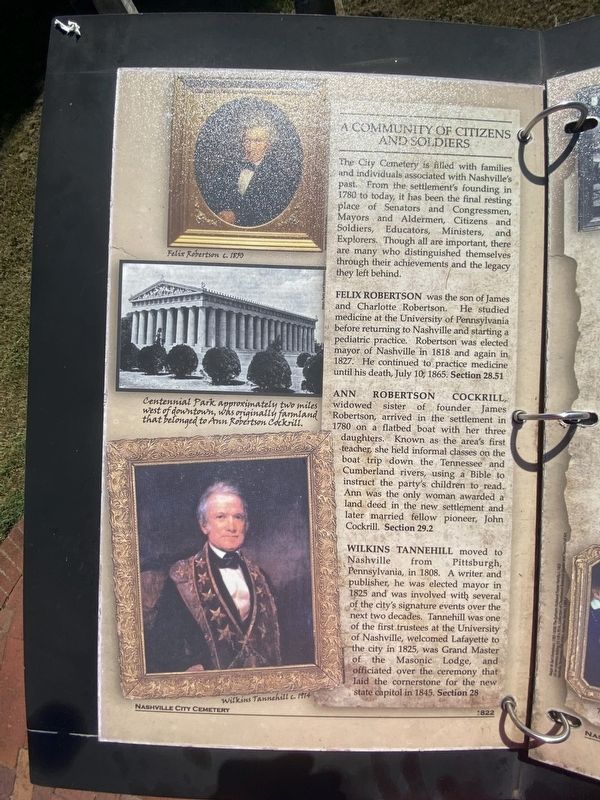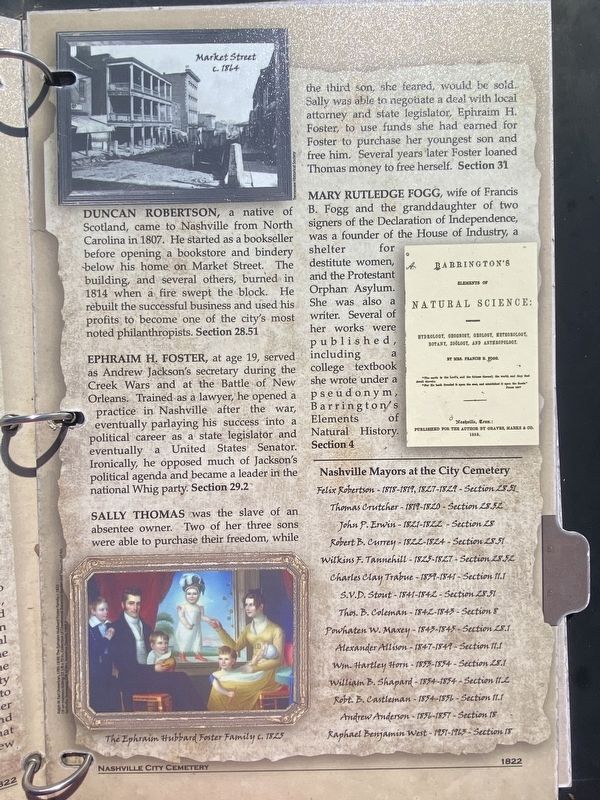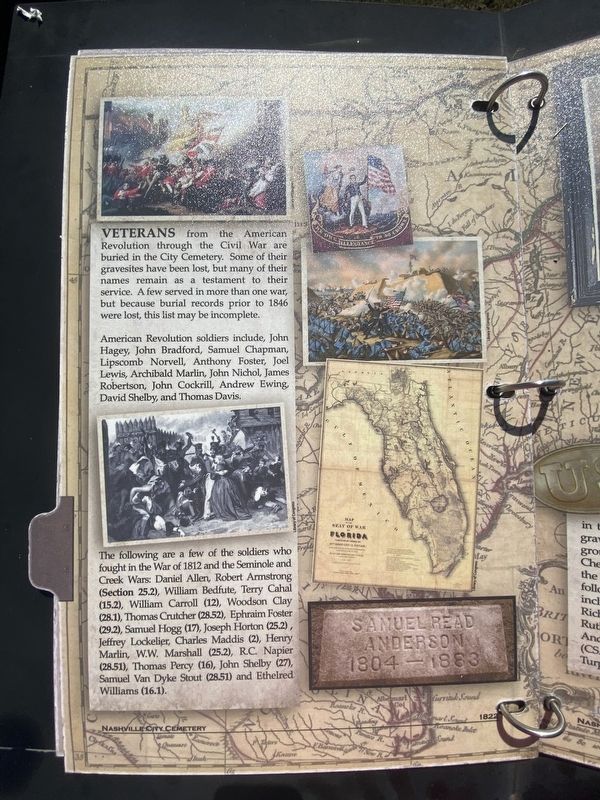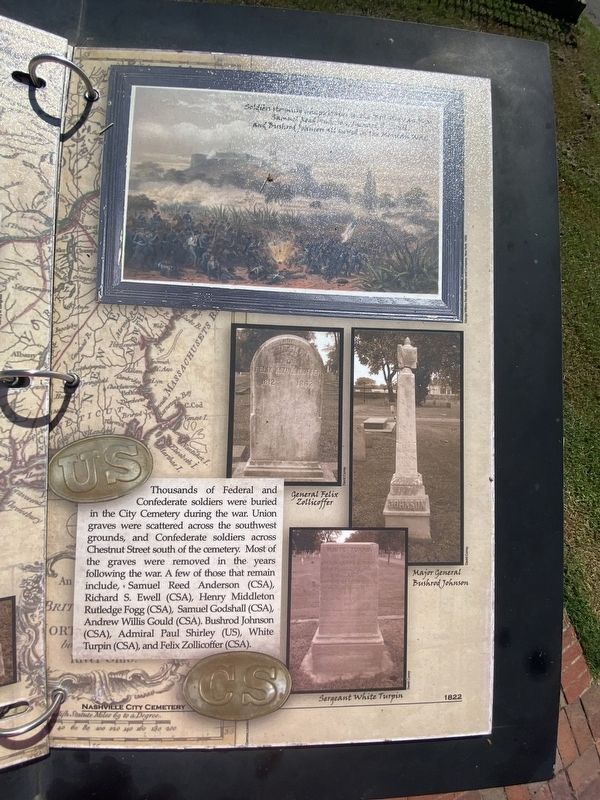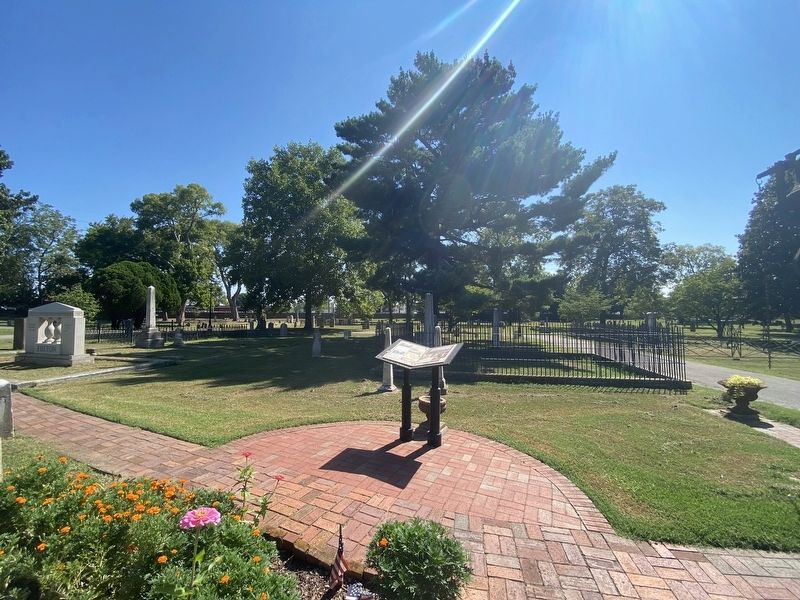South Nashville in Davidson County, Tennessee — The American South (East South Central)
A Community of Citizens and Soldiers
Inscription.
The City Cemetery is filled with families and individuals associated with Nashville's past. From the settlement's founding in 1780 to today, it has been the final resting place of Senators and Congressmen, Mayors and Aldermen, Citizens and Soldiers, Educators, Ministers, and Explorers. Though all are important, there are many who distinguished themselves through their achievements and the legacy they left behind.
Felix Robertson was the son of James and Charlotte Robertson. he studied medicine at the University of Pennsylvania before returning to Nashville and starting a pediatric practice. Robertson was elected mayor of Nashville in 1818 and again in 1827. he continued to practice medicine until his death, July 10, 1865.
Ann Robertson Cockrill widowed sister of founder James Robertson, arrived in the settlement in 1780 on a flatbed boat with her three daughters. Known as the area's first teacher, she held informal classes on the boat trip down the Tennessee and Cumberland rivers, using a Bible to instruct the party's children to read. Ann was the only woman awarded a land deed in the new settlement and later married fellow pioneer, John Cockrill.
Wilkins Tannehill moved to Nashville from Pittsburgh, Pennsylvania, in 1808. A writer, and publisher, he was elected mayor in 1825 and was involved with several of the city's signature events over the next two decades. Tannehill was one of the first trustees at the University of Nashville, welcomed Lafayette to the city in 1825, was a Grand Master of the Masonic Lodge, and officiated over the ceremony that laid the cornerstone for the new state capitol in 1845.
Duncan Robertson, a native of Scotland, came to Nashville from North Carolina in 1807. He started as a bookseller before opening a bookstore and bindery below his home on Market Street. The building and several others, burned in 1814 when a fire swept the bock. He rebuilt the successful business and used his profits to become on e of the city's most noted philanthropists. Section 28.51
Ephraim H. Foster, at age 19, served as Andrew Jackson's secretary during the Creek Wars and at the Battle of New Orleans. Trained as a lawyer, he opened a practice in Nashville after the war, eventually parlaying his success into a political career as a state legislator and eventually a United States Senator. Ironically, he opposed much of Jackson's political agenda and became a leader in the national Whig party. Section 29.2
Sally Thomas was the slave of an absentee owner. Two of her three sons were able to purchase their freedom, while the third son, she feared, would be sold. Sally was able to negotiate deal with
local attorney and state legislator, Epharim H. Foster, to use funds she had earned for Foster to purchase her youngest son and free him. Several years later Foster loaned Thomas money to free herself. Section 31.
Mary Rutledge Fogg, wife of Francis B. Fogg and the granddaughter of two signers of the Declaration of Independence, was a founder of the House of Industry, a shelter for destitute women, and the Protestant Orphan Asylum. She was also a writer. Several of her works were published, including a college textbook she wrote under a pseudonym warrington's Elements of Natural History. Section 4.
Veterans from the American Revolution through the Civil War are buried in the City Cemetery Some of their gravesite have been lost, but many of their names remain as a testament to their service. A few served in more than one war, but because burial records prior to 1846 were lost, this list may be incomplete.
American Revolution soldiers include, John Cagey, John Bradford, Samuel Chapman, Lipscomb Norvell, Anthony Foster, Joel Lewis, Archibald Marlin, John Nichol, James Robertson, John Cockrill, Andrew Ewing, David Shelby, and Thomas Davis.
The following are a few of the soldiers who fought in the War of 1812 and the Seminole and Creek Wars: Daniel Allen, Robert Armstrong (Section 25.20, William Bedfute, Terry Cahal (15.2),
William Carroll (12), Woodson Clay (28.1), Thomas Crutcher (28.52), Epharim Foster (29.2), Samuel Hogg (17), Joseph Horton (25.2), Jeffrey Likelier, Charles Maddis (2), Henry Marlin, W.W. Marshall (25.2), R.C. Napier (28.51), Thomas Percy (16), John Shelby (27), Samuel Van Dyke Stout (28.51) and Ethelred Williams (16.1).
Thousands of Federal and Confederate soldiers were buried in the City Cemetery during the war. Union graves were scattered across the southwest grounds, and the Confederate soldiers across Chestnut Street south of the cemetery. Most of the graves were removed in the years following the war. A few of those that remain include, Samuel Reed Anderson (CSA), Richard S. Ewell (CSA), Henry Midleton Rutledge Fogg (CSA), Samuel Godshall (CSA), Andrew Willis Gould (CSA), Bushrod Johnson (CSA), Admiral Paul Shirley (US), White Turpin (CSA) and Felix Zollicoffer (CSA).
Topics. This historical marker is listed in this topic list: Cemeteries & Burial Sites. A significant historical date for this entry is July 10, 1865.
Location. 36° 8.841′ N, 86° 46.164′ W. Marker is in Nashville, Tennessee, in Davidson County. It is in South Nashville. Marker can be reached from 4th Avenue South. Touch for map. Marker is at or near this postal address: 1001 4th Ave S, Nashville TN 37210, United States of America. Touch for directions.
Other nearby markers. At least 8 other markers are within walking distance of this marker. Nashville City Cemetery (a few steps from this marker); From Frontier to Civilization
(a few steps from this marker); Frontier Nashville / Athens of the West (within shouting distance of this marker); William Carroll (within shouting distance of this marker); The Civil War and Its Aftermath (within shouting distance of this marker); Andrew Ewing (within shouting distance of this marker); Cemetery Monument and Architecture (about 300 feet away, measured in a direct line); John E. Hagey (about 300 feet away). Touch for a list and map of all markers in Nashville.
Credits. This page was last revised on February 7, 2023. It was originally submitted on September 3, 2022, by Darren Jefferson Clay of Duluth, Georgia. This page has been viewed 106 times since then and 18 times this year. Photos: 1, 2, 3, 4, 5. submitted on September 4, 2022, by Darren Jefferson Clay of Duluth, Georgia. • Mark Hilton was the editor who published this page.
